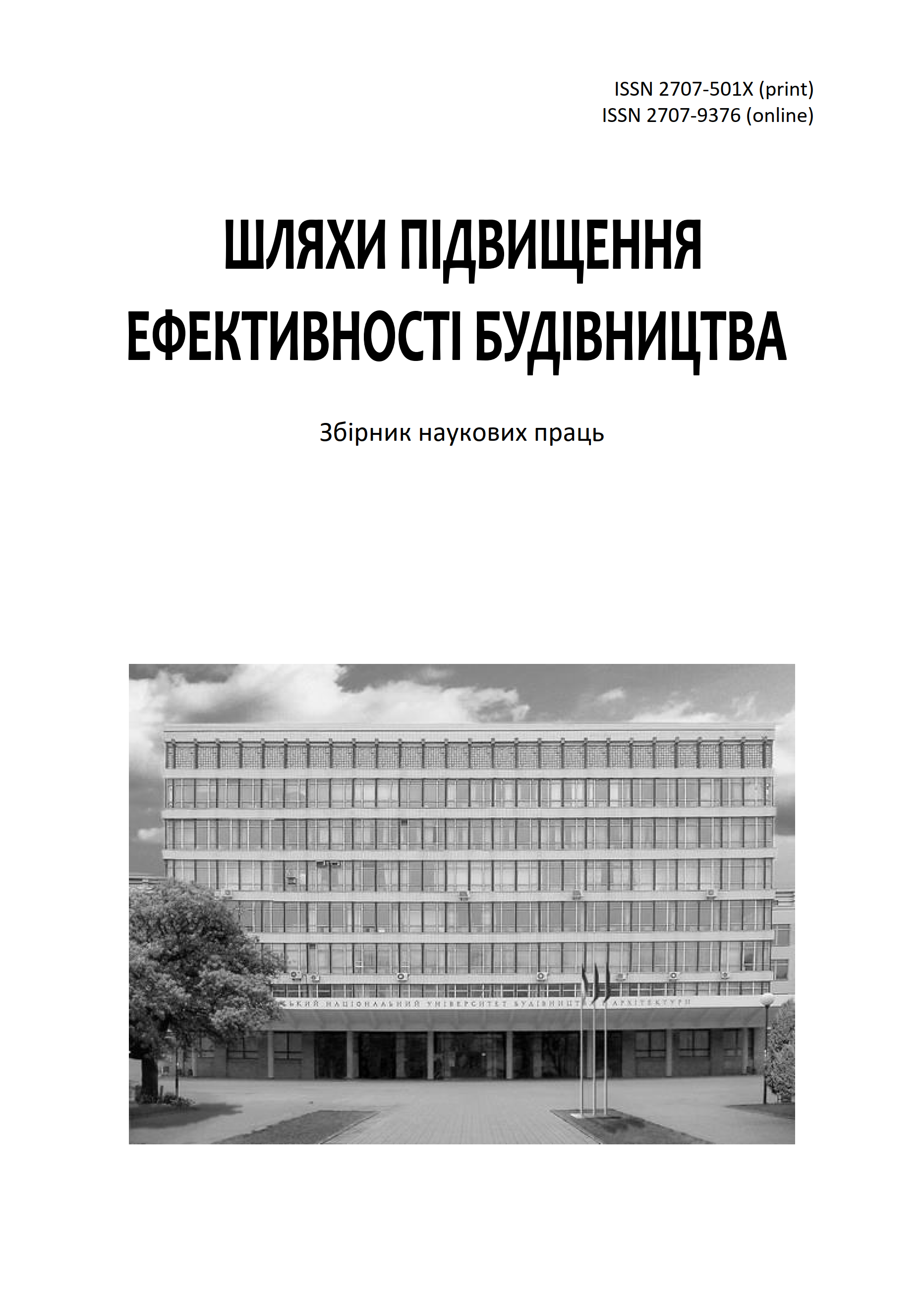Public-private partnership as a tool for involving construction enterprises to participate in post-war reconstruction projects of Ukraine
Keywords:
Public-private partnership, construction enterprises, reconstruction, attraction of resources, infrastructure projects, restorationAbstract
Public-private partnership (PPP) is becoming a key tool in attracting construction companies to participate in construction projects in Ukraine. This form of cooperation between public authorities and the private sector has the potential to implement significant infrastructure facilities that contribute to economic recovery and raising the standard of living of the population.
In the context of post-conflict reconstruction, PPPs enable the pool of resources, finance and expertise of the private sector to be mobilized for the rapid and effective recovery of affected areas. Construction companies can make a significant contribution to the reconstruction of infrastructure, housing stock, social and commercial facilities that have been destroyed or damaged as a result of the conflict.
PPP creates favorable conditions for investment in construction and reconstruction, ensuring transparency, protection of investors' rights and stability of the conditions for concluding deals. In addition, this mechanism promotes the development of innovative approaches in the construction industry, the introduction of environmentally friendly technologies and the creation of new jobs.
Thanks to the implementation of the PPP in the reconstruction process, Ukraine can carry out a quick and high-quality recovery of the economy and infrastructure, contributing to the stabilization of the situation in the affected territories and raising the standard of living of the population.
The advantages of public-private partnership in this area are obvious. First, they can pool resources and expertise from both the public and private sectors. Secondly, the PPP promotes the development of competition and the improvement of the quality of work. When competitive conditions are created, the best quality and most efficient solutions are more easily chosen, leading to the improvement of the national infrastructure.
In addition, PPP ensures transparency and openness in project implementation. This ends up building the confidence of both investors and the public, which is a factor in the success of large-scale infrastructure projects. After a period of conflict and crisis, building and restoring infrastructure has become a key challenge for Ukraine. This requires large-scale financial and technical resources, which the state cannot always provide. Therefore, the use of public-private partnership (PPP) becomes a strategic step towards restarting the construction and development of infrastructure.
References
Абрамов Л. К., Азарова Т. В. Цільові програми та механізми по забезпеченню прозорості у процесі їх реалізації: навчальний посібник. Кіровоград: ІСКМ, 2010. 100 с.
Авксєнтьєв М.Ю. Моделі інституційної підтримки державно-приватного партнерства в світі та в Україні. Формування ринкових відносин в Україні: 2010. Вип. № 3 (106). С. 49-54
Безбах Н. В. Аналіз ризиків при формуванні механізмів державно-приватного партнерства у сфері матеріальних резервів. Наукові розвідки з державного та муніципального управління, 2011. Вип. 2. С. 284–291.
Безбах Н. В. Методологічні аспекти організації державноприватного партнерства. Наукові розвідки з державного та муніципального управління. 2011. Вип. 1. С. 275–285.
Boehm B. A Spiral Model of Software Development and Enhancement". ACM SIGSOFT Software Engineering Notes. 1986. 11 (4): 14–24.
Брайловський І. А. Аналіз підходів до класифікації моделей державно-приватного партнерства. Вісник Одеського національного університету, 2013. Т. 18. Вип. 3/1. С. 60–63.
Брайловський І. А. Моделі державно-приватних партнерств. Розвиток економічних методів управління національною економікою та економікою підприємства: зб. наук. праць ДонДУУ. Донецьк: ДонДУУ, 2012. т. XIII. С. 51–60.
Головинов О. М., Дмитриченко Л. А. Науково-практичні аспекти державно-приватного партнерства в освіті. Економіка та право. 2013. № 1. С. 84–89.
Головинов О. М. Державне-приватне партнерство в інноваційних сферах. Вісник економічної науки України. 2010. 1. С. 47 – 51
Дутко Н. Державно-приватне партнерство: можливості та перспективи для розвитку. Управління сучасним містом. 2008. №1-4/1-12. С.33-43.
Запатріна І., Лебеда Т. Державно-приватне партнерство як фактор економічного зростання та проблеми його розвитку в Україні. Економіст. 2011. №3. С. 52-58., с. 57
Ляхович О. О. Інституційні та договірні форми державно-приватного партнерства. Вісник Хмельницького національного університету. 2012. Т. 3. № 4. С. 248–251.
Маісурадзе М. Ю. Передумови розвитку державно-приватного партнерства в Україні. Економіка та держава. 2014. № 2. С. 11–14.
Черчата А. О. Державно-приватне партнерство як результат інтеграції держави та бізнес-структур //Scientific Bulletin of Ivano-Frankivsk National Technical University of Oil and Gas (Series: Economics and Management in the Oil and Gas Industry). – 2020. – №. 1 (21). – С. 94-102.
Чуприна Ю. А. Проблеми розвитку будівельних кластерів як механізмів реалізації державних інвестиційних цільових програм //Управління розвитком складних систем. – 2018. – №. 36. – С. 120-125.
Chuprina Y. A simulation model for choosing strategies for the interaction of business and government in implementing public-private partnership programs //Ways to Improve Construction Efficiency. – 2018. – №. 38. – С. 14-27.
Дутко Н. Г. Державно-приватне партнерство: перспективи розвитку. Інвестиції: практика та досвід. 2020. № 4. С. 109–114.
Круглов В. В. Ризики проектів державно-приватного партнерства. Вчені записки Таврійського національного університету імені В. І. Вернадського. Серія : Державне управління. 2018. Т. 29 (68). № 2. С. 87–91.
Downloads
Published
How to Cite
Issue
Section
License

This work is licensed under a Creative Commons Attribution 4.0 International License.
Authors who publish with this journal agree to the following terms:
- Authors retain copyright and grant the journal right of first publication with the work simultaneously licensed under a Creative Commons Attribution License that allows others to share the work with an acknowledgement of the work's authorship and initial publication in this journal.
- Authors are able to enter into separate, additional contractual arrangements for the non-exclusive distribution of the journal's published version of the work (e.g., post it to an institutional repository or publish it in a book), with an acknowledgement of its initial publication in this journal.
- Authors are permitted and encouraged to post their work online (e.g., in institutional repositories or on their website) prior to and during the submission process, as it can lead to productive exchanges, as well as earlier and greater citation of published work (See The Effect of Open Access).

